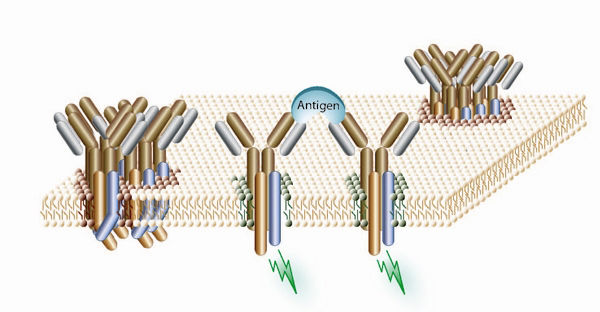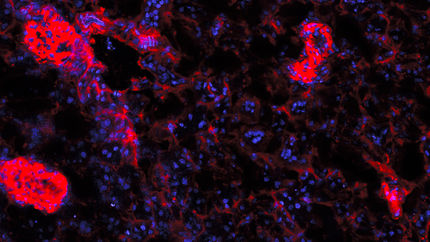One lock, many keys
Advertisement
In order to track down pathogens and render them harmless, the immune system must be able to recognize myriad different foreign substances and react to them. Scientists at the Max Planck Institute of Immunobiology and the Centre for Biological Signalling Studies BIOSS at the University of Freiburg have discovered how the immune system's B-cells can be activated by numerous substances from our environment. The receptor molecules on the surface of the B-cells are only activated when the receptor subunits separate following the binding of foreign substances. These findings turn the previous understanding of how B-cell receptors are activated on its head and may contribute to the development of new vaccination strategies and treatments for B-cell tumours.

On resting B-cells, the B-cell receptor forms oligomers from several subunits. The receptors are inactive in this form. The binding of the receptor to a matching binding partner (antigen) results in the dissolution of this oligomer structure and activates the signalling chains in the cell interior (flashes).
MPI für Immunbiologie
Many human diseases, like the increasing number of autoimmune diseases and B-cell tumours such as leukaemia and lymphoma, are triggered by overactive receptors on the surface of white blood cells known as B-lymphocytes or B-cells. Each B-cell has up to 120,000 B-cell receptors on its surface. The activation of these receptors causes the cell to form antibodies. The receptors work on the basis of the lock and key principle, whereby a receptor (the lock) can only be activated by a matching substance (key) and trigger an immune response. If millions of keys can open one lock, the question arises as to how this lock works and how we are protected against the continuing over-activity of our immune response.
Jianying Yang und Michael Reth have now found an answer to this mystery of immune system activation. Using methods from synthetic biology they recreated the mouse B-cell receptor in a fruit-fly cell. Unlike in the previous research carried out in this area, the focus of their attention was the receptor on resting B-cells, the non-activated cells. To their surprise they discovered that the receptor on resting B-cells consists of several different sub-units and forms oligomers. In this form, sectors of the receptors that play an important role in signal transmission are concealed. If a matching binding partner bonds to the receptor, the oligomers disintegrate and the individual sub-units can become active. "The separation process is largely dependent on the structure of the binding partner. This explains why the B-cell receptor can be activated by thousands of different substances," explains Michael Reth from the Max Planck Institute of Immunobiology. The discovery that the sub-units of the B-cell receptors form ordered oligomer complexes also leads to the conclusion that the receptors on resting B-cells can only be activated under precisely defined conditions.
The new model for the activation of the receptor is at variance with the hitherto accepted scientific doctrine. Up to now it was believed that the receptors exist in an unordered form in the cell membrane and only aggregate when they make contact with a binding partner. "In contrast, our new model is based on the dissolution and not the formation of a particular receptor structure. This marks a turning point in immunology research and, possibly also, in the field of cell biology," stresses Michael Reth. It appears that other receptor molecules also form oligomers in a resting state which only become active when they disintegrate into subunits or change their conformation.
Original publication: Jianying Yang and Michael Reth; "Oligomeric organization of the B cell antigen receptor on resting cells"; Nature, 467:465-469: September 23, 2010
Other news from the department science
Most read news
More news from our other portals
See the theme worlds for related content
Topic world Antibodies
Antibodies are specialized molecules of our immune system that can specifically recognize and neutralize pathogens or foreign substances. Antibody research in biotech and pharma has recognized this natural defense potential and is working intensively to make it therapeutically useful. From monoclonal antibodies used against cancer or autoimmune diseases to antibody-drug conjugates that specifically transport drugs to disease cells - the possibilities are enormous

Topic world Antibodies
Antibodies are specialized molecules of our immune system that can specifically recognize and neutralize pathogens or foreign substances. Antibody research in biotech and pharma has recognized this natural defense potential and is working intensively to make it therapeutically useful. From monoclonal antibodies used against cancer or autoimmune diseases to antibody-drug conjugates that specifically transport drugs to disease cells - the possibilities are enormous




















































